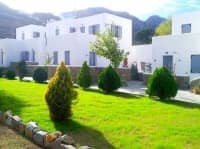Thirasia: Forgotten over Time
In the shadow of Santorini (Thira), Thirasia can offer an alternative for those seeking authenticity, tranquility, and solitude. Along with Santorini, Thirasia was part of the island of Strongyle which separated after the great eruption of 1600 BC. Thirasia now forms part of the perimeter of the large caldera that formed in the years following the eruption. Its geomorphology closely resembles that of Santorini, but in contrast to the better known island, touristic development here has mainly focused on visitors who come as part of the daily tours of boats that depart from the port of Thira to visit the volcano on Nea Kameni and Palea Kameni. The reality for those who want to really know the island and love it is fortunately different.
The island is small (less than 10 square kilometers) and easy to roam around. It has a satisfactory road network with paved roads and passable dirt roads, but it is preferable to explore it on foot, at least in the places cars don’t go.
The capital of the island is Manolas, which was built on the brow of the steep slope of the caldera (volcanic crater). Quiet and picturesque, it is an ideal destination for those seeking a brief escape from the tourist crowds of Santorini. Two hundred seventy steps connect it with its seaport, the picturesque harbor of Korfos. Interesting and picturesque settlements are Potamos (inhabited) and Agrilia (the oldest settlement on the island, no longer inhabited). The main port of the island is Riva, in the village of Agia Irini in the north.
The island is of great archaeological interest, as much as Santorini, but since none of the excavations are accessible to the general public the interest is restricted to archaeologists and historians. Some of the most notable of the visible findings that have survived are at the little Church of Christ (located approximately 1,200 meters south of Agrilia). At the northern end of the wall surrounding the church, part of a circular Hellenistic/Classical era tower has survived.
At the little Church of Christ, a passable path (or damaged dirt road) begins. After approximately 1,200 meters, it leads to the southwestern tip of the island, the Kimina area, and the mines of S. Alafouzos. The 19th century pumice mining operation here brought to light traces of buildings of a Late Bronze Age settlement, among them a complete building which was originally excavated by Alafouzos and Nomikos in 1866 and subsequently by Ferdinand Fouqué (a French petrologist and geologist) in 1867. The pumice extracted here was used in the construction of the Suez Canal.
There were also mines in the northern part of the island. From Manolas, follow the dirt road that heads north. After 500 meters the road forks; the part heading left leads to the little Church of Saint John, while the branch on the right goes to the northern mines in Kastro or Paliokastro. Here, at the highest part of the steep eastern slope, early Byzantine settlement remains from the 7th to 9th century AD have been identified. Both the position and the layout of the settlement strongly resemble the fortified site of the castle on the rock of Skaros in Santorini.
Of particular interest are the elaborate and brightly painted churches of the island, epitomized by the Church of the Virgin Mary of Lagadi in Agrilia. But the most important religious landmark is the Monastery of the Dormition (or Assumption) of the Virgin Mary, which is located near the southeastern tip of the island on Cape Trypiti. It was built in 1851 and consists of 18 cells. The monastery's Church of the Dormition is noteworthy for its Russian gold iconostasis with the Evangelists and the Apostles Peter and Paul. As in the area around the Church of the Prophet Elias, archaeological studies near the monastery have turned up indications of a significant ancient site in the region. This is supported by both the ancient architectural elements in the monastery and also by numerous pottery finds. The view from this point toward the caldera (volcanic crater) is gorgeous.
The highest accessible point on the island is the little Church of the Prophet Elias. Following the road that heads south from Manolas to the southern tip of the island and the Monastery of the Dormition, about three hundred meters from the Church of Saint Haralambos, we see on our left a steep uphill road that leads to the gorgeous little Church of the Prophet Elias (Profitis Ilias) at almost the highest point on the island (290 meters). Archaeological investigations have shown that the area around the summit near the Church of the Prophet Elias was the main residential center of the island in antiquity, in both archaic and Roman times. Very beautiful view from above, both to the west with the vastness of the Aegean, and toward the caldera (volcanic crater), Korfos, and farther north, Oia.
Thirasia has a few "wild" volcanic beaches with black stones and pebbles. Most noteworthy are the two beaches in the village of Agia Irini (Riva), the first at the port and the second farther south of the village, and those in the western part of the island. There is also one more in the north, the beach of Agios Nikolaos, which is inaccessible by land, beneath the steep slopes of the caldera.


